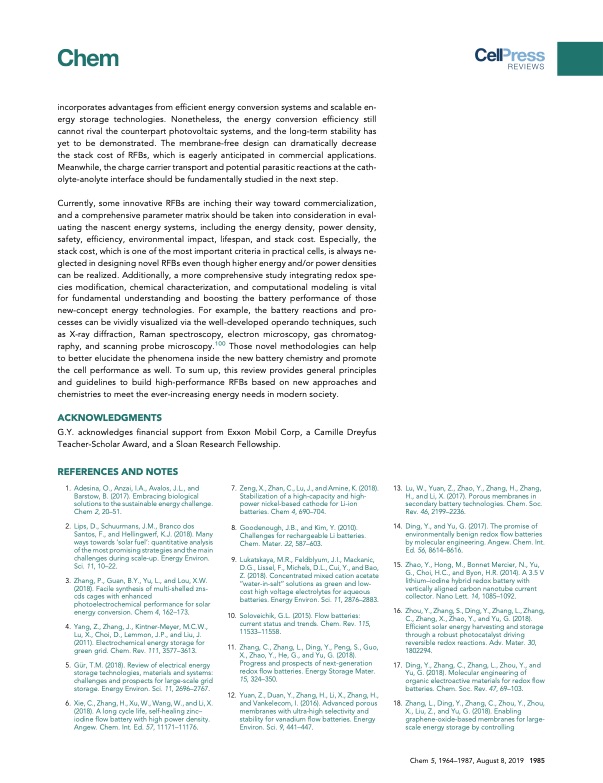
PDF Publication Title:
Text from PDF Page: 022
incorporates advantages from efficient energy conversion systems and scalable en- ergy storage technologies. Nonetheless, the energy conversion efficiency still cannot rival the counterpart photovoltaic systems, and the long-term stability has yet to be demonstrated. The membrane-free design can dramatically decrease the stack cost of RFBs, which is eagerly anticipated in commercial applications. Meanwhile, the charge carrier transport and potential parasitic reactions at the cath- olyte-anolyte interface should be fundamentally studied in the next step. Currently, some innovative RFBs are inching their way toward commercialization, and a comprehensive parameter matrix should be taken into consideration in eval- uating the nascent energy systems, including the energy density, power density, safety, efficiency, environmental impact, lifespan, and stack cost. Especially, the stack cost, which is one of the most important criteria in practical cells, is always ne- glected in designing novel RFBs even though higher energy and/or power densities can be realized. Additionally, a more comprehensive study integrating redox spe- cies modification, chemical characterization, and computational modeling is vital for fundamental understanding and boosting the battery performance of those new-concept energy technologies. For example, the battery reactions and pro- cesses can be vividly visualized via the well-developed operando techniques, such as X-ray diffraction, Raman spectroscopy, electron microscopy, gas chromatog- raphy, and scanning probe microscopy.100 Those novel methodologies can help to better elucidate the phenomena inside the new battery chemistry and promote the cell performance as well. To sum up, this review provides general principles and guidelines to build high-performance RFBs based on new approaches and chemistries to meet the ever-increasing energy needs in modern society. ACKNOWLEDGMENTS G.Y. acknowledges financial support from Exxon Mobil Corp, a Camille Dreyfus Teacher-Scholar Award, and a Sloan Research Fellowship. REFERENCES AND NOTES 1. Adesina, O., Anzai, I.A., Avalos, J.L., and Barstow, B. (2017). Embracing biological solutions to the sustainable energy challenge. Chem 2, 20–51. 2. Lips, D., Schuurmans, J.M., Branco dos Santos, F., and Hellingwerf, K.J. (2018). Many ways towards ‘solar fuel’: quantitative analysis of the most promising strategies and the main challenges during scale-up. Energy Environ. Sci. 11, 10–22. 3. Zhang, P., Guan, B.Y., Yu, L., and Lou, X.W. (2018). Facile synthesis of multi-shelled zns- cds cages with enhanced photoelectrochemical performance for solar energy conversion. Chem 4, 162–173. 4. Yang, Z., Zhang, J., Kintner-Meyer, M.C.W., Lu, X., Choi, D., Lemmon, J.P., and Liu, J. (2011). Electrochemical energy storage for green grid. Chem. Rev. 111, 3577–3613. 5. Gu ̈ r, T.M. (2018). Review of electrical energy storage technologies, materials and systems: challenges and prospects for large-scale grid storage. Energy Environ. Sci. 11, 2696–2767. 6. Xie, C., Zhang, H., Xu, W., Wang, W., and Li, X. (2018). A long cycle life, self-healing zinc– iodine flow battery with high power density. Angew. Chem. Int. Ed. 57, 11171–11176. 7. Zeng, X., Zhan, C., Lu, J., and Amine, K. (2018). Stabilization of a high-capacity and high- power nickel-based cathode for Li-ion batteries. Chem 4, 690–704. 8. Goodenough, J.B., and Kim, Y. (2010). Challenges for rechargeable Li batteries. Chem. Mater. 22, 587–603. 9. Lukatskaya, M.R., Feldblyum, J.I., Mackanic, D.G., Lissel, F., Michels, D.L., Cui, Y., and Bao, Z. (2018). Concentrated mixed cation acetate ‘‘water-in-salt’’ solutions as green and low- cost high voltage electrolytes for aqueous batteries. Energy Environ. Sci. 11, 2876–2883. 10. Soloveichik, G.L. (2015). Flow batteries: current status and trends. Chem. Rev. 115, 11533–11558. 11. Zhang, C., Zhang, L., Ding, Y., Peng, S., Guo, X., Zhao, Y., He, G., and Yu, G. (2018). Progress and prospects of next-generation redox flow batteries. Energy Storage Mater. 15, 324–350. 12. Yuan, Z., Duan, Y., Zhang, H., Li, X., Zhang, H., and Vankelecom, I. (2016). Advanced porous membranes with ultra-high selectivity and stability for vanadium flow batteries. Energy Environ. Sci. 9, 441–447. 13. Lu, W., Yuan, Z., Zhao, Y., Zhang, H., Zhang, H., and Li, X. (2017). Porous membranes in secondary battery technologies. Chem. Soc. Rev. 46, 2199–2236. 14. Ding, Y., and Yu, G. (2017). The promise of environmentally benign redox flow batteries by molecular engineering. Angew. Chem. Int. Ed. 56, 8614–8616. 15. Zhao, Y., Hong, M., Bonnet Mercier, N., Yu, G., Choi, H.C., and Byon, H.R. (2014). A 3.5 V lithium–iodine hybrid redox battery with vertically aligned carbon nanotube current collector. Nano Lett. 14, 1085–1092. 16. Zhou, Y., Zhang, S., Ding, Y., Zhang, L., Zhang, C., Zhang, X., Zhao, Y., and Yu, G. (2018). Efficient solar energy harvesting and storage through a robust photocatalyst driving reversible redox reactions. Adv. Mater. 30, 1802294. 17. Ding, Y., Zhang, C., Zhang, L., Zhou, Y., and Yu, G. (2018). Molecular engineering of organic electroactive materials for redox flow batteries. Chem. Soc. Rev. 47, 69–103. 18. Zhang, L., Ding, Y., Zhang, C., Zhou, Y., Zhou, X., Liu, Z., and Yu, G. (2018). Enabling graphene-oxide-based membranes for large- scale energy storage by controlling Chem 5, 1964–1987, August 8, 2019 1985PDF Image | Development of Redox Flow Batteries Based on New Chemistries

PDF Search Title:
Development of Redox Flow Batteries Based on New ChemistriesOriginal File Name Searched:
PIIS2451929419302207.pdfDIY PDF Search: Google It | Yahoo | Bing
Salgenx Redox Flow Battery Technology: Salt water flow battery technology with low cost and great energy density that can be used for power storage and thermal storage. Let us de-risk your production using our license. Our aqueous flow battery is less cost than Tesla Megapack and available faster. Redox flow battery. No membrane needed like with Vanadium, or Bromine. Salgenx flow battery
| CONTACT TEL: 608-238-6001 Email: greg@salgenx.com | RSS | AMP |